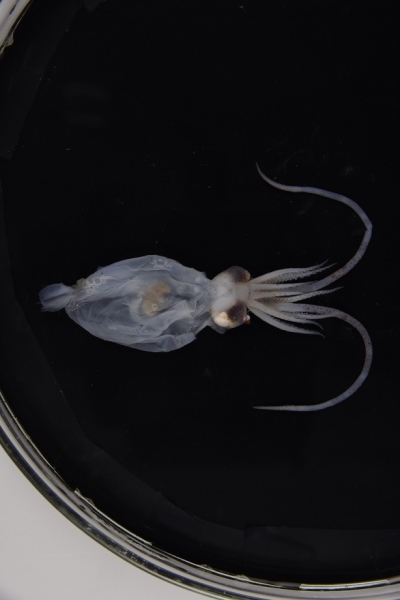Another colossal squid is under examination in Wellington, but this one could fit in the palm of your hand.
The baby Mesonychoteuthis¸ which measures about 12 cm in total length, was collected by NIWA during the New Zealand-Australia Antarctic Ecosystems Voyage earlier this year and frozen on board the ship until it could be examined by New Zealand teuthologists (squid scientists) from Auckland University of Technology.
The find was particularly exciting for Dr Kat Bolstad, who heads AUT’s Lab for Cephalopod Ecology and Systematics (ALCES), and PhD candidate Aaron Evans, who studies the family Cranchiidae (“glass squids”), to which the colossal squid belongs.
Careful examinations of the tiny colossal squid revealed it to be in very good condition, with the characteristic hook/sucker combination already present on the arms. The rest of the animal looks very different from the large specimens recently examined at the National Museum of New Zealand Te Papa Tongarewa.
Good timing
Evans and Bolstad said that the baby colossal came along at exactly the right time. They are currently finalising a paper describing the species’ growth and appearance throughout its lifespan, and the new specimen is about half the size of their next-smallest specimens – also collected by NIWA during an International Polar Year survey in 2007-2008.
“We’re very lucky to have the range of specimens we do in New Zealand collections, from the small individuals housed at NIWA to the very large females we’ve been able to research at Te Papa,” said Evans.
“We know that glass squids’ appearance changes dramatically between the time they are very small and when they reach adulthood – many go from being almost completely transparent, with strange eyes on long stalks and ridiculous tiny fins, to being dark red or even purple black, with large round eyes and fins. It’s great to be able to trace this development throughout different life stages.”
As well as examining the baby squid’s morphology (overall appearance), the team plan to conduct some molecular analyses, investigating genetic diversity within the species, in collaboration with NIWA and Te Papa researchers.
Further information
Visit NIWA's Antarctic Ecosystems Voyage homepage

